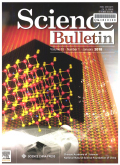- 钛学术文献服务平台 \
- 学术期刊 \
- 基础科学期刊 \
- 自然科学总论期刊 \
- 科学通报(英文版)期刊 \
null
An insight into the cells' glycans and lectin-glycosensing sites
基本信息来源于合作网站,原文需代理用户跳转至来源网站获取
摘要:
Glycosylation produces a diverse and abundant repertoire of glycans that help protein folding and cellular secretion [1].Glycoproteins often sprout sialic acid (alias N-acetyl neuraminic acid,abbreviated as Neu5Ac) at the termini of their N-and O-glycans in a process called sialylation [2].Alterations to the normal function of the glycosylation machinery,including increased branching of N-linked glycans and sialylation,are major hallmarks of cancer progression.Particularly,increased sialylation on the cell surface induces tumor proliferation by promoting cell detachment from primary tumors through charge repulsion [3].Despite the potential of increased or altered sialylation as diagnostic and prognostic biomarkers,there is still no early glycosensing platform that can be ubiquitously applied to detect glycans sialylation in diverse bio-samples with high selectivity and sensitivity.

推荐文章
期刊_丙丁烷TDLAS测量系统的吸收峰自动检测
带间级联激光器
调谐半导体激光吸收光谱
雾剂检漏 中红外吸收峰 洛伦兹光谱线型
不同盐度、温度及光照对漂浮浒苔生理生态的影响
浒苔
盐度
温度
光照
生理生态
期刊_联合空间信息的改进低秩稀疏矩阵分解的高光谱异常目标检测
高光谱图像
异常目标检测 低秩稀疏矩阵分解 稀疏矩阵 残差矩阵
内容分析
关键词云
关键词热度
相关文献总数
(/次)
(/年)
引文网络
引文网络
二级参考文献 (10)
共引文献 (4)
参考文献 (10)
节点文献
引证文献 (0)
同被引文献 (0)
二级引证文献 (0)
1989(1)
- 参考文献(1)
- 二级参考文献(0)
2003(1)
- 参考文献(0)
- 二级参考文献(1)
2005(2)
- 参考文献(1)
- 二级参考文献(1)
2006(2)
- 参考文献(1)
- 二级参考文献(1)
2007(2)
- 参考文献(0)
- 二级参考文献(2)
2008(1)
- 参考文献(0)
- 二级参考文献(1)
2009(1)
- 参考文献(1)
- 二级参考文献(0)
2010(2)
- 参考文献(0)
- 二级参考文献(2)
2011(1)
- 参考文献(0)
- 二级参考文献(1)
2012(2)
- 参考文献(2)
- 二级参考文献(0)
2013(1)
- 参考文献(1)
- 二级参考文献(0)
2014(2)
- 参考文献(1)
- 二级参考文献(1)
2015(2)
- 参考文献(2)
- 二级参考文献(0)
2016(0)
- 参考文献(0)
- 二级参考文献(0)
- 引证文献(0)
- 二级引证文献(0)
引文网络交叉学科
相关学者/机构
期刊影响力
科学通报(英文版)
主办单位:
中国科学院
出版周期:
半月刊
ISSN:
1001-6538
CN:
11-1785/N
开本:
大16开
出版地:
北京东黄城根北街16号
邮发代号:
2-177
创刊时间:
1950
语种:
eng
出版文献量(篇)
9507
总下载数(次)
1
总被引数(次)
58070
期刊文献
相关文献
推荐文献
- 期刊分类
- 期刊(年)
- 期刊(期)
- 期刊推荐
力学
化学
地球物理学
地质学
基础科学综合
大学学报
天文学
天文学、地球科学
数学
气象学
海洋学
物理学
生物学
生物科学
自然地理学和测绘学
自然科学总论
自然科学理论与方法
资源科学
非线性科学与系统科学
科学通报(英文版)2022
科学通报(英文版)2021
科学通报(英文版)2020
科学通报(英文版)2019
科学通报(英文版)2018
科学通报(英文版)2017
科学通报(英文版)2016
科学通报(英文版)2015
科学通报(英文版)2013
科学通报(英文版)2012
科学通报(英文版)2011
科学通报(英文版)2010
科学通报(英文版)2009
科学通报(英文版)2008
科学通报(英文版)2007
科学通报(英文版)2006
科学通报(英文版)2005
科学通报(英文版)2004
科学通报(英文版)2003
科学通报(英文版)2002
科学通报(英文版)2001
科学通报(英文版)2000
科学通报(英文版)2016年第9期
科学通报(英文版)2016年第8期
科学通报(英文版)2016年第7期
科学通报(英文版)2016年第6期
科学通报(英文版)2016年第5期
科学通报(英文版)2016年第4期
科学通报(英文版)2016年第3期
科学通报(英文版)2016年第24期
科学通报(英文版)2016年第23期
科学通报(英文版)2016年第22期
科学通报(英文版)2016年第21期
科学通报(英文版)2016年第20期
科学通报(英文版)2016年第2期
科学通报(英文版)2016年第19期
科学通报(英文版)2016年第17期
科学通报(英文版)2016年第16期
科学通报(英文版)2016年第15期
科学通报(英文版)2016年第14期
科学通报(英文版)2016年第13期
科学通报(英文版)2016年第12期
科学通报(英文版)2016年第11期
科学通报(英文版)2016年第10期
科学通报(英文版)2016年第1期

 免费查重
免费查重










